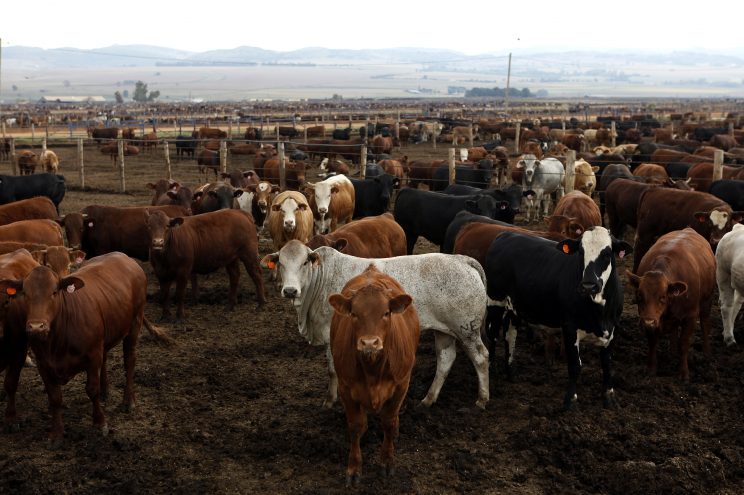By Bongiwe Zwane-Maseko
80 000 cattle, which are considered the main form of livelihood for Emaswati died during the 2015/6 drought and destocking has been proposed as a solution to this. This is one of the recommendations made in the Drought Forecast-based Action Feasibility and Scoping Study 2021 on Eswatini. The Report was prepared for Baphalali Eswatini Red Cross Society with financial support from the British Red Cross and technical support from the Red Cross Red Crescent Climate Centre. The report recommends that rural livestock farmers be equipped with livestock management skills in drought-prone areas, which may include encouraging destocking to reduce drought losses.

Agriculturists say destocking is aimed at removing the affected animals before they become emaciated, lose their value, die or pose a risk to public health. The exercise enables farmers to salvage some capital from their livestock at risk, support families with cash to meet their food needs and other basic needs, relieve pressure on scarce water and pasture resources and protect their livelihoods and strengthen the community’s ability to recover from the short and long effects of drought. Direct beneficiaries include the most vulnerable mainly orphans, people living with disability, the elderly and the chronically ill.
The study further recommends the promotion of small-scale, home-based fodder production in neighbouring areas with grass, preservation, and stockpiling.
“There is a need to encourage destocking through the sale of non-productive livestock in platforms such as annual auctions and training farmers about the benefits of destocking. The relocation of herds from drought-stricken areas to areas not affected by drought also needs to be encouraged. This also includes the provision of training and awareness campaigns for local-level range management teams.
“Training and distribution of cash for animal care kits to protect and increase the recovery of sick animals is also critical, as is the training of communities on the interpretation of weather and drought forecasts,” reads the report.
Persistent drought shortages have led to some farmers shifting from livestock farming to other forms of livelihood.
“Many of us here used to have a lot of cattle. In fact, livestock farming was our most important and prestigious form of livelihood here which made us very proud. I used to have more than fifty cattle but I have none now. They all died and it was very sad to see them die before my eyes. I then lost interest in keeping livestock. At times I would watch about six cattle lying helplessly on the ground, dying. I don’t ever want to remember that. I will never return to cattle farming. There is nothing for them to eat here – they eat the soil,” said a resident of Ntfutfukwati in the Lubombo region.
180 000 Emaswati affected by drought
Drought continues to be the most prevalent and destructive natural hazard that threatens rural livelihoods in Eswatini.
This is one of the conclusions made in the Drought Forecast-based Action Feasibility and Scoping Study 2021 on Eswatini. The Report was prepared for Baphalali Eswatini Red Cross Society with financial support from the British Red Cross and technical support from the Red Cross Red Crescent Climate Centre.
It states that the reliance on rainfed agriculture by rural communities increases their vulnerability to drought impacts, such as the death of livestock and crop failure, which is often associated with a decline in yield and loss of income.
“Drought is less understood and tends to be confused with dry spells by most rural communities who still find it challenging to even access weather forecast data and properly interpret information related to weather forecasts. To improve rural resilience and reduce vulnerability and exposure to drought, a shift to drought-tolerant and early-maturing crops is recommended to reduce drought-related crop losses,” the report reads.
It further recommends that rural livestock farmers be equipped with livestock management skills in drought-prone areas, which may include encouraging destocking to reduce drought losses.
“Providing drought forecast information should also be prioritised, in addition to educating rural communities on the proper interpretation of drought and weather insecurity. Above all, it can be concluded that a week-planned anticipatory approach to drought risk management could reduce shocks emanating from these impacts, hence the need for an early action-triggering system for drought,” the report states.
In the past decade, Eswatini has faced food insecurity and nutritional challenges as a result of sequential periods of droughts. Currently, an average of almost 14
per cent of the population (180 000 people) per year is potentially affected by droughts.
“For instance, an estimated 290 000 people in the country faced a livelihood crisis in 2013/14 compared to 116 000 people in 2011/12, where people were struggling to earn a living due to the failure of livelihoods to generate income. Approximately 5 per cent of the population required immediate food assistance as the country faced a deficit of 32 486 metric tonnes of food in the same assessment period. Factors contributing to food insecurity include declining income earning opportunities and remittances, weakened capacity for governance, abject poverty, high levels of unemployment, high food prices, and the high prevalence of HIV,” the report reads.
It further that the trends of droughts generally increased from 1981 to 2018 and moderate droughts are expected approximately every four years in the Highveld while extreme drought is expected after every 19 to 25 years in the same region.
“In the Middleveld, moderate droughts were observed to recur every four years while extreme droughts were observed every 12 to 15 years. In the Lowveld, the frequency analysis revealed that moderate droughts are expected every 3 to 4 years while extreme droughts are observed to occur every 9 to17 years. The frequency of severe droughts fell between that of moderate and extreme droughts for all the agroecological zones,” states the report.
It further states that food security is persistently affected, and the country’s poorer communities are most at risk of global climate variations and global commodity price fluctuations.
“Droughts, therefore, exacerbate the country’s challenges to produce enough food to cover domestic requirements, contributing to the food insecurity of an estimated 20-25 per cent of the population. During the 2015/16 drought, for instance, an estimated 25 per cent of Eswatini’s population was severely food insecure, which contrasts with the 2012 figure which was 7 per cent. While food insecurity can cause lasting damage to future generations and the environment, it can also cause physical harm ranging from malnutrition to death,” the report reads.
It is highlighted that during the same period, about 620 000 people received support from the government and various agencies either as in-kind or cash transfers while over 80 000 cattle deaths were recorded.




